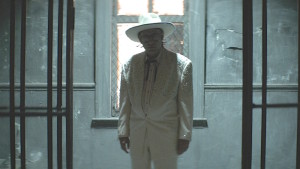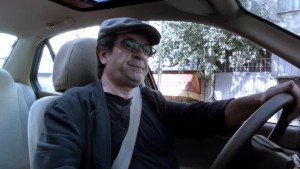
With a trailer that bills itself as a light-hearted little feature that has a dog bringing together a ton of people, Todd Solondz and his marketing team have effectively ensured that most people who step into Wiener-Dog will hate him. But, in some weird way, maybe Wiener-Dog actually is his happiest (or at least most accessible) movie, offering at least an ounce of closure in a sea of melancholy.
Split into four wildly different short films, two of which are tied together narratively and two of which simply appear out of thin air, Wiener-Dog falls comfortably into the dysfunctional universe that Solondz has created over the years. They’re all loosely tied together by the fact that the lovely titular dachshund is involved in the lives of at least one person in each story, but other than that, they simply exist as unique entities that serve to explore similar themes to the rest of his movies.
It’s his aesthetic through and through, though there’s an added beauty to the way Edward Lachman shoots the often-dreary world of Solondz. This isn’t to say that his other films are unappealing to view—always wonderfully lit and drenched in pastel colors to contrast the tonal well of despondence—but they don’t have quite the sheen that Wiener-Dog does. Even Life During Wartime, also shot by Lachman, has a different glow to it. As the camera trails over piles of dog diarrhea in the film’s first part, set to Debussy’s “Clair de Lune,” it all looks so very polished and fantastical as though trying to cover up grim realities.
The film’s music is just as essential to how good it is. Nina Persson and Nathan Larson deliver yet another stellar piece of music for Solondz to join what they’ve already contributed: a tune fairly similar in execution to Palindromes’ “Lullaby” but lighter in mood with Persson singing the two syllables in “Doodie” in varying manners. As a hilarious contrast, there’s also Marc Shaiman’s “The Ballad of Wiener-Dog”, featured during a short intermission between the four parts that involves the dachshund trailing across all sorts of green-screen landscapes.
To discuss each part in depth would give away many of the charms that Wiener-Dog has to offer in its writing and generally amusing scene concepts. They vary in tone and in levels of realism as usual, with something like a mother trying to explain spaying and dog-rape to her son who recently survived cancer leaning to the ridiculous while a white film production student being entirely unable to explain to his what movies inspire him because “there’s just so many” proving an all-too funny moment that rings true. But there’s also the overwhelming feeling of Solondz looking into the depths of the human soul here, specifically mortality and those feelings of unfulfilled potential that plague us all. One of the best moments comes when Ellen Burstyn’s Nana is faced with a dozen visions of her younger self (played by Melo Ludwig), uncomfortably and amusingly stating all the ways her life could have gone differently.
This notion of alternate realities is something that echoes through most of Wiener-Dog, but nowhere as prominently as in its second part, which features Welcome to the Dollhouse’s Dawn Wiener all grown up. Bringing back Dawn Wiener in an alternate reality (one where she didn’t commit suicide after becoming obese and pregnant as shown in Palindromes) is an interesting decision, and one that shows that Solondz has a surprising soft-spot for this character. Criticisms of Greta Gerwig’s interpretation of Wiener will come easily; her looks and her cadence strikingly different to what one would imagine from a grown-up Heather Matarazzo, but she serves Solondz well in the fairly different woman he writes here.
Dawn is no long as brash as she once was. Removed from her family and all the things that seemingly held her down in negativity, her willingness to hope for the best shines as she not only saves Doodie and offers him a better home more than once, but seemingly finds something real with her former flame Brandon, this time played by Kieran Culkin, who scores one of the film’s most emotionally compelling roles and delivers beautifully on it.
Life isn’t as bleak as Mark Wiener described it at the end of Palindromes in his conversation with Aviva, the film’s protagonist, played by Jennifer Jason Leigh in the scene they share (and one of eight actresses to play the role). “We hope or despair because of the way we’ve been programmed. Genes and randomness, that’s all there is and none of it matters.” Wiener-Dog may maintain Todd Solondz’s efforts to make us sympathize with individuals who are varying levels of fucked-up, but where settling for the inevitability of existence and death was his former concern, this film feels like someone taking a breath of fresh air and remembering that the way we lead our lives might actually matter in the long-run. That is, until we’re hit by that crippling reminder that death is waiting just across the street.
—
Directed by Todd Solondz; written by Todd Solondz; starring Keaton Nigel Cooke, Tracy Letts, Julie Delpy, Greta Gerwig, Kieran Culkin, Connor Long, Bridget Brown, Danny DeVito, Ellen Burstyn, Zosia Mamet, Michael James Shaw & Melo Ludwig; 90 minutes.
Wiener-Dog is currently experiencing a limited theatrical release. In Miami, an 8pm screening of the film at Miami Beach Cinematheque on Saturday, July 9th, will be followed by an hour long Q&A with filmmaker Todd Solondz, hosted by Miami Art Zine Critic Rubén Rosario.



 Derek
Derek
 Isabelle
Isabelle